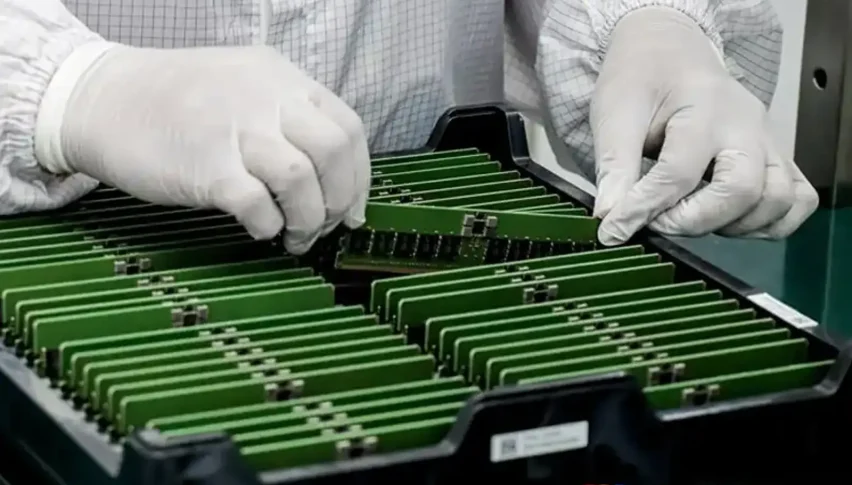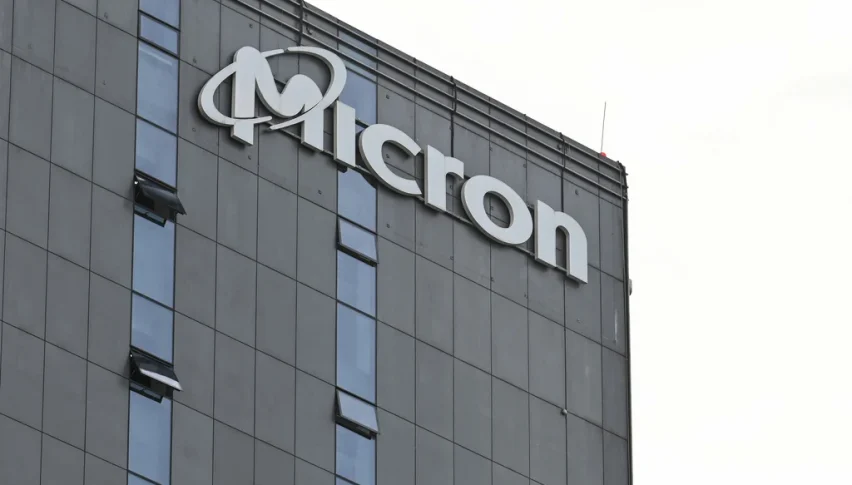Micron MU Stock Rebounds Off Support Targeting the Highs Again
Micron Technology’s meteoric rise continues to impress, but growing competition in the high-bandwidth memory (HBM) market and renewed...

Quick overview
- Micron Technology has seen a 106% stock increase in 2025, driven by the AI boom and high demand for high-bandwidth memory.
- Despite impressive financial results, including a 998% year-over-year net income increase, Micron faces challenges from rising competition and geopolitical tensions.
- The HBM market is becoming crowded with competitors like Samsung and SK Hynix ramping up production, raising concerns about potential oversupply.
- While Micron's long-term outlook remains strong, short-term volatility is expected due to competitive pressures and trade uncertainties.
Micron Technology’s meteoric rise continues to impress, but growing competition in the high-bandwidth memory (HBM) market and renewed trade friction are testing investor confidence.
Micron Rides the AI Memory Wave
Micron Technology (NASDAQ: MU) has emerged as one of 2025’s standout performers, capitalizing on the global AI boom and surging demand for high-bandwidth memory (HBM) — a crucial component for AI servers and data centers. The company’s stock has soared 106% year-to-date, cementing its role as a cornerstone of the semiconductor supply chain.
At its recent peak, Micron’s market capitalization reached $202 billion, reflecting both its technological leadership and robust financial performance. However, after printing a fresh record above $201 on Monday, MU shares lost momentum through the week, tumbling to $180 by Friday as escalating U.S.–China trade rhetoric unsettled investors.
China’s declaration of plans to reduce rare earth exports reignited fears of supply chain disruption, prompting a global risk-off move that hit tech stocks particularly hard. Still, with tensions now easing and both sides softening their tone, risk sentiment has improved, helping MU rebound more than 6% to above $183 early this week.
Record Financial Results Strengthen Market Standing
Micron’s performance this year has been nothing short of exceptional. The company continues to outpace Wall Street expectations, buoyed by strong tech-driven demand and an effective operational strategy.
In its fiscal Q4 2025 earnings, Micron reported:
- Revenue: $11.32 billion — up 46% year-over-year
- Adjusted EPS: $3.03 — well above analyst forecasts
- Full-year revenue: $37.38 billion, a 49% increase
- Net income: $8.5 billion, surging 998% year-over-year
Much of this growth came from the data center division, now contributing over 56% of total sales, as AI training workloads and next-generation memory architectures drive unprecedented demand. The results confirm Micron’s strategic pivot toward AI-focused solutions is paying off, bolstering its competitive positioning against rivals like Samsung and SK Hynix.
Market Volatility Returns as Competition Heats Up
Despite Micron’s impressive fundamentals, last week’s sharp correction reflected a combination of profit-taking, geopolitical risk, and competitive anxiety in the semiconductor space.
MU’s weekly chart shows a clear break in momentum, with investors pausing to reassess valuations after an extended rally. The stock’s decline to $180 marked a 10% retreat from record highs, even as the broader market recovered Monday.
MU Stock Chart Daily – Investors Eye Support Levels
Technicians point to the $175–$180 zone as critical short-term support. A sustained break below that level could trigger a deeper correction toward $160, while a decisive rebound above $190 would restore bullish momentum.
MU Stock Chart Daily – The 20 SMA Holding As Support
Analysts at Barclays and Citi noted that Micron’s strong AI exposure remains a long-term advantage, but warned that “investors are pricing in near-perfect execution.” The risk, they argue, is that the HBM market — currently supply-constrained — could shift to oversupply in late 2026 as multiple producers ramp capacity.
Competitive Pressures and Strategic Challenges
The HBM segment, once dominated by just a few key players, has become increasingly crowded. Both Samsung and SK Hynix are rapidly scaling their HBM4 production pipelines, while new entrants in China and Taiwan are investing aggressively to capture market share.
While Micron’s technology roadmap — including its next-generation HBM4E chips — remains ahead in performance metrics, analysts caution that price competition could squeeze margins in the coming quarters. Maintaining differentiation through innovation and efficiency will be key as the AI infrastructure build-out matures.
Additionally, lingering trade uncertainties pose another challenge. With rare earth materials essential to chip production, any renewed export restrictions or tariff escalation could disrupt the supply chain, adding volatility to semiconductor valuations.
Outlook: Strong Fundamentals, Fragile Sentiment
Micron’s story in 2025 has been one of remarkable growth and execution. The company is delivering record results, scaling production efficiently, and riding the AI wave more effectively than most peers. Yet, investors appear mindful that rapid growth in a cyclical, capital-intensive industry rarely comes without turbulence.
As the company moves toward fiscal 2026, the twin forces of competition and policy risk will likely define short-term price action. While long-term prospects remain bright, the near-term challenge lies in balancing growth expectations with market realities.
Micron’s rally may pause, but its leadership in AI memory solutions ensures that it remains a cornerstone of the semiconductor narrative — and a bellwether for how the AI revolution translates into lasting value.
- Check out our free forex signals
- Follow the top economic events on FX Leaders economic calendar
- Trade better, discover more Forex Trading Strategies
- Open a FREE Trading Account

